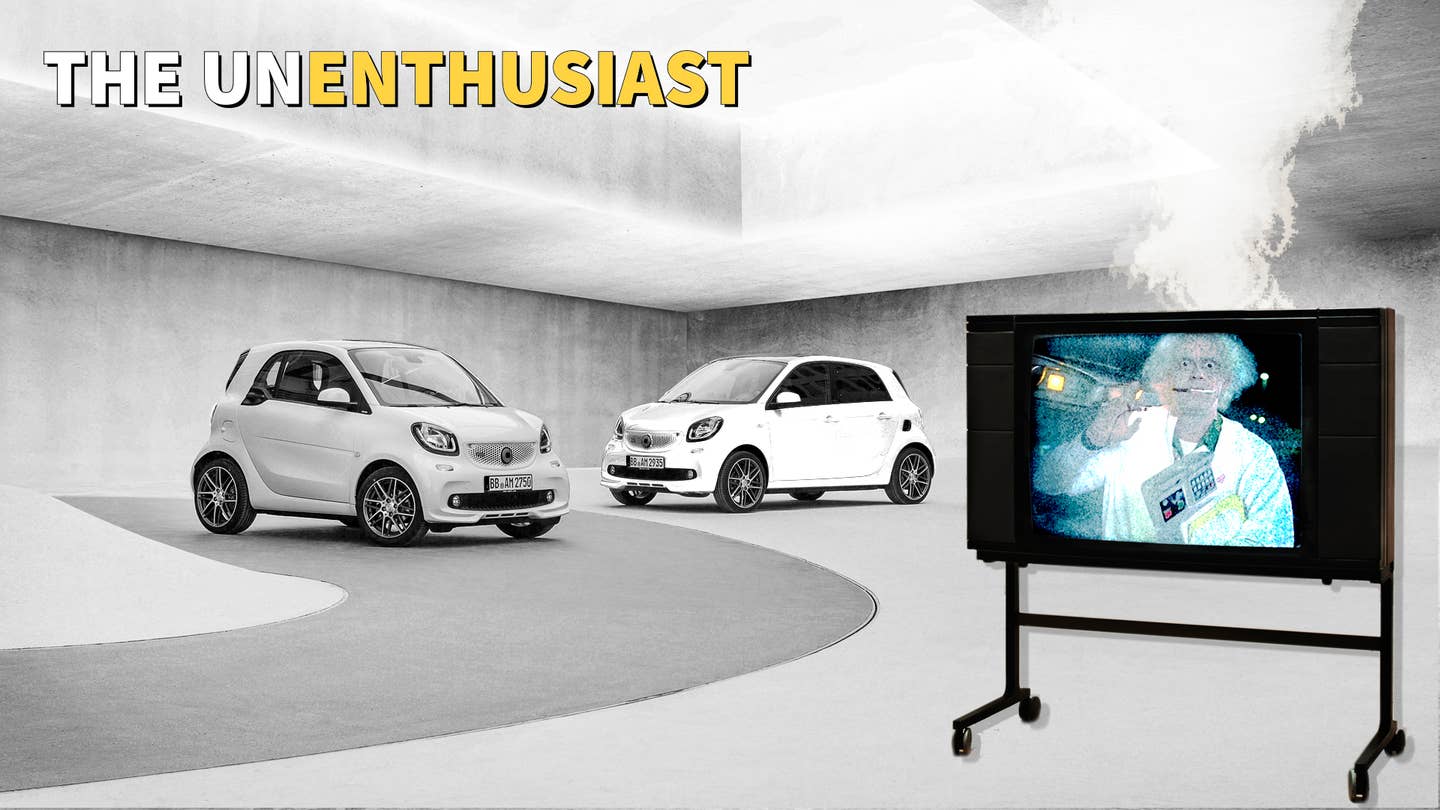My High School Teacher Predicted the Future of Cars
35 years later, turns out that Mr. Ziriax was right—about most of it, anyway.

Back in the days when Winona Ryder played kids, not moms, in the hot, hip movie of the moment, I had a junior-high science teacher named Mr. Ziriax. Despite his science-fictiony name, Mr. Ziriax was not an alien being, though to us cosseted suburban Phoenix kids, he might as well have been one. His head was as smooth as Mork’s egg, and he was as white as the Mormon Tabernacle Choir; he had tiny round glasses and a goatee. Befitting his status as a science teacher, he never wore anything but white, short-sleeved collared shirts and black polyester pants. Mr. Ziriax weighed 250 pounds if he weighed 300 pounds. He was enormous and weird.
And he drove to school every day in a single-seat electric car.
Mr. Ziriax didn’t own a golf cart like the ones my friends’ fathers puttered around in while they were making fraudulent savings-and-loans deals. He had an ostensibly legitimate car—a tiny white thing with a slanted roof-to-trunk windshield under which, in the Phoenix sun, he must have baked every afternoon like a cheese soufflé. When he pulled into the parking lot, the top opened with a puff of smoke (at least in my imagination), and Mr. Ziriax emerged from his vehicle like a steamed Protoceratops.
“This,” he told us when we mocked him, “is the future of cars!”
I had a hard time imagining that he was anything but crazy. We lived in the age of the bitchin’ Camaro, of the 12-mpg Cadillac boat, the last rusty dregs of the Detroit doldrums. At best, the future of cars was a time-traveling DeLorean. An unadorned, one-man electric, barely bigger than a seated lawnmower and meant only to be driven five to seven miles a day, seemed insane. Almost un-American.
Here we are, 35 years later. We all carry phone-computers in our pockets. Yet from where I sit, on the grim conveyor belt of SUV death in Texas, it appears that not much has changed, automotively. Cars are “better” in a certain sense; they have vacuums and TVs and cameras and powerful engines that can eat your lunch. But this future looks a lot like the past, only with better badging.
Still, there are signs, if you know where to look. The mammals are eating the dinosaur eggs. The Ziriax Prophecy is coming true, and then some.
Submitted for your approval: a study released last month by the University Of California, Berkeley, Transportation Sustainability Research Center, an outfit whose name in no way makes it sound like an organization set up by the Obama Administration to destroy capitalism. The UOCBTSRC gathered data from 9,500 car2go car-sharing service subscribers in five North American cities and unearthed some cool stuff.
On average, the study found, each car2go took 11 vehicles off city streets. In 2015 alone, car2go removed 28,000 privately-owned cars from Washington, D.C., San Diego, Seattle, Calgary, and Vancouver combined. The very presence of a decent car-sharing service helped avert 146 million miles traveled, eliminating nearly 39,000 metric tons of greenhouse gases.
“Six thousand fewer cars in Calgary” doesn’t exactly sound like a revolution. And anyone who’s driven in a car2go knows that if this is the only future we get, then SkyNet had best descend now, because it represents a serviceable dystopia at best. Those Smart ForTwos have a turning radius of a spinning top, but not much else going on; even while being shared, they still chew more fuel than they should, and they often smell like a sweaty brogrammer who just used them to make a run to Trader Joe’s for fake Oreos.
Yet the Berkeley study also provides clear, objective evidence that car-sharing actually can help save lives and prevent countless miseries. The people in the study had given up their cars for car2go, cars that had an average age of 14.4 years. That’s thousands of 2001 Mazda Protégés, with emission systems designed when Pokemon was a brand-new TV show, off the roads, replaced by tiny machines that can easily be stowed in unused corners of university parking lots.
If you’re not comfortable replacing your 2003 Impreza with a subscription to a Daimler pod, or don’t live in an area where that’s possible, the news of the last few days points toward a future with more choice. Ford is developing autonomous cars that it will sell to some Uber-like company, and quite possibly place in an autonomous, subscription-based Ford fleet. Also breaking was the news that BMW is preparing an electric 3-series alternative, and buried under that was something even more significant: It’s working on its own car-sharing service. You’ll be able to drive a BMW, but you won’t have to own one. You won’t even have to rent one. It’ll just be a subscription, like Netflix, or a data plan, or that monthly porn service on your secret credit card.
Some of us will be driving around little electric pods in the future. That’s radical enough. Many of us will be sitting in cars that drive themselves. That’s really radical. But most radical of all is something that Mr. Ziriax himself couldn’t have predicted in that suburban middle-school parking lot 35 years ago: We won’t have to own cars.
That simple fact can change the world, as long as I don’t have to exclusively share a Smart Car.
